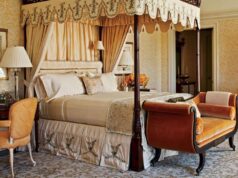For all the hunkering at home that’s transpired over the last two years, it’s unsurprising that homeowners have been designating more interior areas for all things leisure-driven.
For some, that might mean a room full of blobby furniture for cuddling, a biophilic corner for plant bathing and meditation, an enveloping book nook, or an honorary space for mixing froufrou tipples.
And for those that have chosen to earnestly tune in, there’s heightened interest towards creating dedicated listening rooms to reset moods, quell anxiety, and get lost in an atmosphere of sound.
Whether folks dance it out or not, the music clearly matters: Vinyl sales are at a 30-year high, and designers, furniture makers, and audio specialists are fielding substantial requests from those seeking help getting high on music at home.
“A great listening room can do things we only dream of. It’s a time machine, it’s a transporter,” says Adam Wexler, founder and owner at Resolution Audio Video, a purveyor of high-end stereos in New York City.
Outfitting a viable listening space is a matter of layout and science, as acoustics is a branch of physics, explains Wexler, who uses these principles to create clean sound spaces for clients, including Atlantic Records COO Julie Greenwald.
The end goal, he says, is minimizing sound reflection. That can be achieved by adding soft surfaces such as rugs, cushy window treatments, pictures on the wall, or other space fillers. Even built-ins can improve conditions. “Shelves of records are great,” Wexler says.
Room size and ceiling heights need to be considered, of course, along with speaker choice and placement. “Ideally a good place to start is an equilateral triangle,” explains Wexler. “Listeners’ ears are the same distance from each speaker as each speaker is from one another.”
Speaker size matters too. Avoid placing giant speakers in a small room, or tiny speakers in a large room. Wexler stresses that most speakers operate optimally when pulled away from the wall. The same principle also applies to seating—leave space behind your lounge chairs if you want to improve the listening experience.
Pam Griffin, an anthropology professor in California and doyenne of vinyl has a personalized 12-by-13-foot listening space and more than 5,800 records. She regularly flashes what’s headed for the turntable via her Instagram handle @pamsrecordcollection. (Spinning recently: Warren Zevon, Roger Daltrey, and El Chicano.)
Griffin, who lives in an open-concept home and utilizes a VPI Prime turntable and Wharfedale EVO 4.3s speakers in her setup, had to get clever with creating sound-friendly borders to define her music zone. “I’ve been fooling with my music room forever. I’ve rearranged it countless times,” she says.
The solution for now, Griffin shares, has been to wrangle two large record cabinets against the longest border of the room to create two “walls.” “One is made of several rattan room dividers which sit behind a pony wall,” says Griffin. “This is really just to create a sense of a separate space from the rest of the house. I’ve also used a record cabinet to create a partial wall that differentiates the music room from the foyer.”
The set up works well, though the sound, as it does, still carries. “Inevitably I’ll want to listen to records at the same time that my husband wants to watch television. Headphones are a must,” she says. Organizing the voluminous collection boils down to a serious strategy: “By genre, then by decade of the artist’s first release, then alphabetically.”
Record enthusiasts looking to level up from storing their vinyl collections in slipshod milk-crates have found the Billy or Kallax shelving units from IKEA to be effective and accessible options. And the 606 Universal Shelving System from Vitsoe offers a modular approach to open media storage.
Symbol Audio, based in Nyack, New York, is a design and audio company helmed by a crew of audiophile makers seeking sleeker, more sophisticated options for media storage in listening spaces. They offer polished versions of the archetypal wooden record stands and crates, but their specialty is custom furniture that can be seamlessly worked into a dining room or living room scheme. One example, the Aero media cabinet, has a midcentury vibe and can be customized with swivel bins for tucking records out of view, but not out of reach.
“Because our furniture doesn’t resemble traditional audio racks, we’ve found that’s allowed folks to integrate vinyl and audio into their homes in ways they wouldn’t have otherwise,” says Walker Tovin, brand manager for Symbol. “Our backgrounds are in traditional furniture design, so we’ve always prioritized crafting a versatile product which can hold its own both in a dedicated listening room or beyond.” But you might have to wait for it: Symbol’s current lead time for order fulfillment is 20 to 22 weeks for most products.
Dallas interior designer Chad Dorsey charmed visitors with his listening room scheme in the 2020 San Francisco Decorator Showcase which featured a custom-made fireplace created by Strike (a brand created by Dorsey himself), the Kekke Longchair by Piet Boon, and a hand-painted ceiling by Porter Teleo.
“We wanted a space that could serve as a retreat for the homeowner, a place to listen to their collection of music, or to listen in silence. A place to read and observe as well,” says Dorsey, who incorporated the unmissable disc-shaped Beoplay A9 speakers from Bang & Olufsen into the design arrangement.
Over the pandemic, Dorsey was asked to level up a recreation room for one client in Texas seeking a quiet listening space for teens. “We took a former playroom and turned it into an upscale lounge with furnishings from Arne Jacobsen, Fritz Hansen, Minotti, the Rug Company, and vintage vinyl-inspired artwork.”
Efficient electricity is also essential to a stellar listening room. According to Wexler, the high quality reproduction of sound—or high fidelity (hi-fi)—will wane if the power supply isn’t up to snuff. “Bad power robs the hi-fi sound of realism.”
Wexler cautions that unstable electricity can compromise sound quality, create noise in your hi-fi system, or even damage it. “If your stereo is plugged into a circuit that is shared with the fridge and dishwasher or lighting dimmers, the performance of your stereo may suffer.” To circumvent problems, he recommends running a dedicated 20 amp power circuit, purchasing an appropriate hi-fi power filtration, or both.
When the moment arrives to test the potency of a client’s sound system, Wexler likes to fire up “Mutations” by Beck.
“The recording is not compressed-sounding like most modern recorded music is; it sounds natural, so it should sound realistic through the hi-fi,” he says. He also cites its wide dynamic range, the air between the instruments, the front and center vocals, and even the silence between the notes. “When something sounds so natural, it’s a great reference.”









